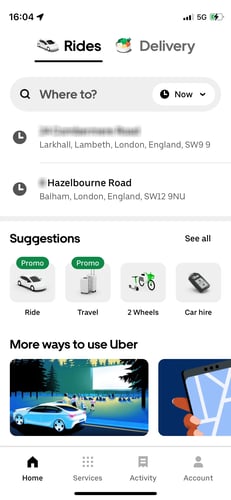This article will delve into the ethical considerations of hyper-personalisation, ensuring the delicate balance between personalisation and privacy is maintained.
In recent years, one buzzword has made quite an impact - hyper-personalisation. As powerful a tool as it is, navigating this terrain requires the grace of a tightrope walker, where one misstep could mean the difference between a successful campaign and a privacy debacle.
With the right approach, hyper-personalisation can enhance the customer experience without overstepping privacy boundaries. Let's explore this balance further.
In this piece, we will cover:
- What is hyper-personalisation in marketing?
- Ethical borders: the fine line between personalisation and intrusion
- The benefits of hyper-personalisation
- Transparent marketing: honouring privacy and preferences
- Personalisation with purpose
- Sending the right message at the right time
- The challenges of hyper-personalisation
What is hyper-personalisation in marketing?
Hyper-personalisation in marketing refers to the use of real-time data, automation, analytics and advanced technologies, such as AI and predictive analytics, to deliver personalised experiences tailored to the individual customer.
It's the next step beyond standard personalisation, involving the creation of a truly individualised customer experience, from targeted marketing campaigns to personalised shopping experiences.

A prime example of this in practice is Uber. From the moment I open the app, it shows me the last places it picked me up from, recommends drop-off locations (my friend's homes in my case), and even suggests I order some food from Uber Eats - because as a Deliveroo fan, I definitely don’t use that app enough!
However, there's a tightrope to walk. While it's impressive that a digital interface can feel so personal and attentive, it raises a crucial question - is there a line where it crosses into the realm of being intrusive?
This delicate balance between effective personalisation and potential intrusion is the heart of hyper-personalisation.
Ethical borders: the fine line between personalisation and intrusion
Hyper-personalisation is a bit like Goldilocks's porridge. Not too hot, not too cold, it needs to be just right. Overdo it, and you risk resembling a digital stalker. Do too little, and your customer might feel overlooked.
It’s important to not personalise for personalisation’s sake - but to enhance the overall customer experience. The optimal times and ways to engage must be calculated considering both the business landscape and the individual's comfort level.
Companies that succeed in hyper-personalisation have managed to use real-time behavioural data to offer hyper-personalised experiences that feel helpful rather than creepy.

A great example is Spotify Wrapped, which allows users to view a compilation of data about their activity on the platform over the past year. This has become so popular that people wait all year for it and share it like crazy on social media. I even still listen to my 2022 Wrapped playlist to this day!
With this and its other hyper-personalisation features, Spotify has hit that sweet spot, where convenience outweighs any potential creepiness, creating an outstanding customer experience that boosts customer loyalty.
The benefits of hyper-personalisation
There's no doubt that marketing has evolved considerably over the years, moving from generic mass campaigns to targeted strategies and now to hyper-personalisation. When businesses decide to integrate a hyper-personalisation strategy into their marketing efforts, they are essentially choosing to step up their game to deliver an enhanced customer experience.
This step can be transformative, leading to a host of advantages that can significantly impact the business's bottom line and customer relationship. Here are a few key benefits that businesses can enjoy when they successfully navigate the implementation of hyper-personalisation in their marketing strategy:
- Improved customer experience: Personalised recommendations and individualised experiences make customers feel valued, leading to increased customer satisfaction and loyalty.
- Increased conversion rates: Personalised content resonates more with customers, leading to improved engagement and higher conversion rates.
- Customer retention: By continually providing relevant content and experiences, businesses can enhance customer relationships and boost customer lifetime value.
- Increased customer loyalty: Hyper-personalisation helps foster deeper emotional engagement, leading to stronger customer loyalty.
Transparent marketing: honouring privacy and preferences
Building a successful hyper-personalisation marketing strategy isn't just about harnessing AI and real-time data. It's also about fostering trust with your customer base. The key to this is transparency.
Transparency is a two-way street in hyper-personalisation. It's about being upfront about what data you're collecting and why, but also giving customers the control to opt in or out and express their preferences. This fosters a deep understanding of the customer and can ultimately lead to a better-personalised customer experience.
A notable example of a company that faced criticism for its approach to hyper-personalisation is Facebook. Facebook has been under fire for its data collection practices and the extent to which it personalises advertisements, raising significant concerns about privacy and user consent.
One specific instance occurred in 2018 when it was revealed that the political consulting firm Cambridge Analytica had improperly obtained data from millions of Facebook users without their explicit consent. This data was then reportedly used to hyper-personalise political advertising during the 2016 U.S. presidential election.
This scandal highlighted the risks of hyper-personalisation when not handled with careful attention to data privacy and ethics. Not only did it damage Facebook's reputation, but it also led to stricter regulations on how companies handle and use customer data for marketing purposes.
The Facebook-Cambridge Analytica incident serves as a stark reminder for businesses to prioritise data ethics and privacy when implementing a hyper-personalisation strategy.
Personalisation with purpose
Personalisation can significantly improve the customer experience, but it's important to ensure that it genuinely adds value. Don't just personalise for personalisation's sake; make sure that the personalised content you're offering is enhancing the customer's experience and journey with your brand.
It's like being at a party where the host remembers not just your name, but also that your favourite drink is an Aperol Spritz and that you love pepperoni pizza. The party becomes an experience, and you, as a guest, feel genuinely cared for and valued.
Sending the right message at the right time
Hyper-personalisation is as much about timing as it is about content. Using AI, automation, and advanced analytics, businesses can discern not only what message would resonate with their customers but also the best time to deliver it. It's like being a skilled archer, knowing both the target and the optimal moment to let the arrow fly.
.webp?width=624&height=327&name=ezgif.com-gif-maker%20(26).webp)
An example of this in action is Netflix's recommendation engine. It doesn't just suggest what you might like to watch based on your viewing history; it considers what time of day it is and what you're likely to want to watch at that moment. In doing so, it adds real value to the customer's online experience.
The challenges of hyper-personalisation
Embarking on the journey of hyper-personalisation might seem like a clear path to improved customer engagement and higher conversion rates, but it's not without its hurdles.
Like any strategy that heavily relies on data and advanced technologies, implementing hyper-personalisation presents a unique set of challenges that businesses must be prepared to tackle. These include:
- Data privacy: As discussed, respecting privacy while collecting and analysing customer data is a delicate balancing act.
- Data accuracy: For hyper-personalisation to work effectively, the data used must be accurate and up-to-date.
- Scalability: Personalising content and experiences at an individual level can be resource-intensive, posing scalability issues for some businesses.
How Huble can help you walk the hyper-personalisation tightrope
Hyper-personalisation marketing, when done right, can significantly boost customer satisfaction, customer retention rates, and conversion rates. However, it is paramount to balance personalisation and privacy.
Respecting customer preferences, transparency in data collection and usage, and delivering timely and relevant content are all essential factors in walking this tightrope effectively.
At Huble, we understand the challenges and opportunities that hyper-personalisation presents. Our expert marketing consultancy team can guide you in creating and implementing a hyper-personalisation strategy that respects privacy, adds value, and enhances your customer journey.
If you're ready to explore the potential of hyper-personalisation for your business without crossing the line into intrusive, we invite you to speak with our team to learn more.




.webp?width=624&height=327&name=ezgif.com-gif-maker%20(26).webp)





.png)





